Posted April 26, 2016
By ROXANNE YU
It’s Saturday and everything seems to be in place. Just before walking into the main PetSmart entrance in Dadeland, a black and white puppy sits comfortably in a cage that seems to be a bit too big for her as visitors come in and out of the pet store.
This week it’s Valerie Gonzalez’s turn to encourage someone to adopt a pet. She brought Janet, a terrier mix puppy she only met a day ago.
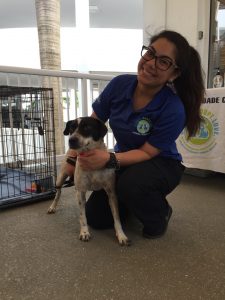
With high hopes Valeria Gonzalez, Animal Services adoption counselor, puts on a reassuring smile knowing that Janet will be adopted in the next few days (Photo by Roxanne Yu).
Each Friday and Saturday of the week, a Miami-Dade Animal Services staff member brings a shelter pet to PetSmart in high hopes that someone will fall in love with the animal and take it home.
Despite achieving its 90 percent save rate goal, Miami-Dade Animal Services continues to improve its programs to create better opportunities for abandoned animals.
Gonzalez, an Animal Services adoption counselor, described various means the shelter took to secure a forever home for every animal brought to the shelter.
“I’ve never seen a dog in the shelter for more than three months. We always create the best opportunities for our pets. Either by pet adoption in the shelter, through foster homes, rescue missions or even by transporting them to another state just to give them a better opportunity to be adopted. We care for these animals and believe that they should all have a chance at being loved,” Gonzalez said.
One of the shelter’s most successful programs is its implementation of the trap, neuter and return (TNR) policies in an effort to reduce cat reproductive levels. Its services also include low-cost spay and neuter operations and affordable vaccination fees to animals that belong in the county.
A more spacious facility with an estimated size that is twice as large as the current shelter is also under construction to replace the main shelter.
Unlike dogs, Animal Services classifies cats as feral and free roaming animals, simply because cats can live on their own whereas dogs are unable to do so. This implies that not all cats brought to the shelter will go through the adoption process. After close inspection by animal specialists, most of these cats will be released back to the environment from which they came.
In spite of the disparity between cats and dogs, the shelter ensures that its TNR program will benefit cat reproduction patterns. This project specifically targets the issue of cat overpopulation, with the intentions of alleviating the problem of cat reproduction count.
Octavio Villafane, the cat receiving staff member for Animal Services, explained the process cats go through once approved for TNR service that is free of charge.
“Feral cats that are brought to the shelter must be from Miami-Dade and at least weigh a pound and a half before we can proceed with the TNR process. We sterilize the cat, give it a booster and rabies vaccine, clip its left ear and then deliver it back to its community,” Villafane said.
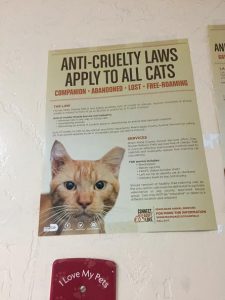
A poster of a cat whose ears have been clipped is hung on one of the walls at Animal Services to inform visitors of its TNR program (Photo by Roxanne Yu).
The shelter enforces a strict no-kill policy that emphasizes its mission to provide care and refuge to the yearly count of 28,000 to 30,000 unwanted dogs and cats.
Gonzalez excitedly shared that it has nearly been two years since the implementation of the no-kill policy and, although it’s been successful in many ways, there are still a considerable number of Miami-Dade citizens who have negative views of the shelter.
“A lot of people are against the shelter because they are not aware of our no-kill policy. Our main goal is to ensure that no animal should go through any kind of suffering. The only time we put down animals is when they have gone through a hit and run and are severely injured that is beyond the point of treatment and operation. We uphold our mission with the more aggressive animals too. We give them anti-depressants to calm them down, and don’t resort to taking their lives,” Gonzalez said.
Lilian Bohorquez, Animal Services spokesperson, further explained the shelter’s platform and no-kill policy success.
Bohorquez said that the shelter has adopted no-kill polices as the guiding principle for pet rescue, steadfastly implementing programs enabling Animal Services to save the highest number of shelter pets in the history of the department. This has played a role in achieving an average of 800 adoptions a month.
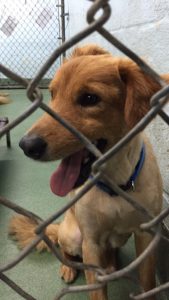
Marley, a seven-month old terrier, has been in the shelter since April 13, 2016. He is in need of a forever home (Photo by Roxanne Yu).
In the state of Florida, Miami-Dade is not the only successful county that has recorded high pet adoption rates.
Okaloosa County’s Panhandle Animal Welfare Society (PAWS), a private and non-profit organization, has made huge strides in adoption through its implementation of a wide range of programs.
Denise Song, community development director of PAWS, attributes the organization’s success to the spread of animal protection awareness across different age groups.
“Our educational program for children is geared to educate them how to approach animals and take good care of them. We take every opportunity we can to educate our community about the spay and neuter process and the importance of getting shots. We do this through a number of activities,” Song said.
Song also eagerly enumerated the different weekly activities PAWS hosts. Creativity plays a significant role when their animals are shown to the public.
Song said PAWS adopted a program that caters specific to office employees. Different companies have partnered with PAWS in order for the last 15 minutes of lunch break to be spent playing with dogs. Other programs include bringing high-energy dogs to running events and water dogs to paddle boarding companies.
The strategy PAWS has adopted confirms its success as an organization. In fact, three times as many adoptions are made when there are community events in the county.
One of the most rewarding moments to experience is when a visitor goes in the shelter without the intention of adopting an animal, but comes out not only with a pet but, with a satisfied feeling of providing a helpless creature with a home.
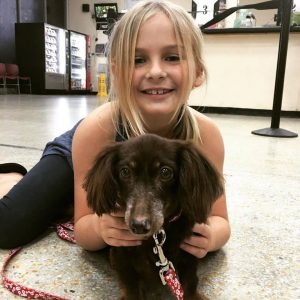
A little girl gave this eight-year old dachshund another chance to be happy and live with a family (Photo courtesy of Miami-Dade Animal Services).
Angela Algee, a native of Orlando who recently adopted a cat at the Orange County Animal Services Shelter, shared why she decided to adopt a shelter kitten.
“I was actually thinking about buying a kitty, but felt really bad not saving one. I decided to adopt right before Thanksgiving and would definitely encourage others to adopt. Saving an animal is just a great feeling and taking it home, caring for it and knowing you made its world is the best,” Algee said.
Undeniably, both private and governmental pet organizations in Florida have had a lot of pet adoption success, however volunteers, who have willingly given their time for these animals, cannot be left unrecognized and unnoticed.
Lubia Rodriguez, Animal Services volunteer coordinator, shared that there are a significant number of volunteers every month.
“We have a handful of volunteers, a total of 100 to 150 active volunteers monthly. Most of these volunteers are students and inmates who are completing their community service hours. It’s good to have them help, but they become inactive once they’ve completed their required hours. Out of the total number of visitors on a yearly basis, I would say only 50 are really active and are dedicated to care for these animals. It’s sad, but it’s the truth,” Rodriguez said.
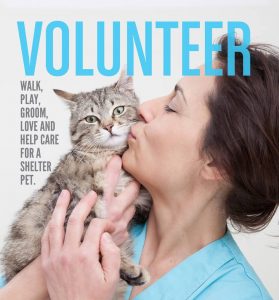
A promotional flyer featuring a volunteer cuddling a cat was released by Animal Services to encourage the public to help out with shelter animals (Photo courtesy of Miami-Dade Animal Services).
While others may consider volunteering inconvenient, there are some who are fully committed to the task, making the most out of their time spent in the shelter.
Emily Smith, a college freshman, is a regular volunteer who has shown passion towards her job and mostly, compassion for the animals she has been around during her stay.
Smith said that although she is not taking veterinary studies, her love for animals has led her to continue to work as a volunteer for the past two months. Additionally, she intends to stay and help out as long as she can.
Apparently, volunteering at the Miami-Dade shelter at 7401 NW 74th St., could be one of the easiest and most fulfilling opportunities, as it does only require applicants to have a deep sense of love for animals. Without an age limit or prior experience requirement, the application is an easy process.
After being convinced by his children, Doneuri Acevedo, a father of two, decided to volunteer in the shelter.
“Today is actually my first day as volunteer and Emily is here to guide and mentor me. I love animals, but am not very open to the idea of keeping a pet at home so my kids encouraged me to volunteer in the event that I might reconsider and have a change of heart,” Acevedo said.
Acevedo also mentioned how it’s been a tiring, yet fulfilling day, walking the dogs, cleaning cages and greeting visitors. He also stated how volunteering is flexible in the way that he can come by the shelter when he is free and not consumed with other responsibilities.
It could be the smiles on the employees’ faces or the enthusiasm they happen to permeate throughout the shelter that seem to help visitors forget the rejection and abandonment that these pets have gone through.
With a cheerful tone Villafane expressed his attachment to the animals and the devotion he has towards his job.
“I’ve always been passionate about animals and I am just so blessed to work here. I thank God every day. This is my career,” Villafane said.
Before you decide to adopt, ask yourself these questions:
- Can I afford to take care of an animal? (food, veterinary visits, grooming, toys)
- Will I have time for my pet? (walking, feeding, bathing, and even playing with it)
- Is my living arrangement suitable for a pet? (for example, only small pets are usually allowed in apartments)
- Will my roommates or house members mind if I get a pet? (seek their approval before you adopt!)
- Am I patient enough to train my pet? (for example, let it know it can’t enter certain places in the house, potty train)
- Can I completely commit to taking care of my pet during its entire life span? (Most pets live until they’re 15)
